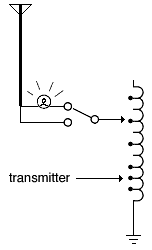
|

|

Chapter 8
Antenna Tuners and Loading Coils
Most transmitters are optimized to work into a 50-ohm non-reactive load. Most homebrew antennas contain some reactance
and have an impedance other than 50 ohms. A device called an antenna tuner (also known as an "ATU" or "transmatch") will transform
your antenna system into a non-reactive load of the proper impedance.
A properly matched antenna will radiate more efficiently and, in some cases, will produce a better-sounding AM signal.
Loading Coils
Instead of a complete and complex antenna tuner, many LPAM stations use a variable inductance located at the transmitter
output jack or at the feedpoint of the antenna. This approach is popular with Part 15 experimenters using simple wire antennas
or shortened verticals. First you insert a tiny "grain of wheat" light bulb, a flashlight bulb, or a similar small lightbulb
between the inductor and the antenna. (Stations using 100 milliwatts might need a bulb rated for 1.5 or 3 volts; operators
using up to 10 watts may need a 6-volt or 12-volt bulb.) Then you try various inductances while the transmitter is on, and
see which setting makes the bulb glow most brightly. Then remove the light bulb from the circuit and transmit.

The variable inductor can be, for example, a coil made of 100 turns of 22-guage (#22 AWG) enameled wire that you wind
around a piece of PVC pipe 2 or 3 inches in diameter, with taps (connection-points) built into the coil every 10 turns; or
any similar inductor.
The various taps in your coil can be wired to a rotary switch, or you can use a small alligator clip to select one at
a time.
The diagram below shows a more elaborate scheme that can be used with a vertical antenna.

One end of the coil is grounded, in other words, connected to earth-ground. That lower third of the coil is made with
several taps 3 or 4 turns apart, and the transmitter can be connected to any of these taps on the ground end of the coil.
From the middle to the top end of the coil are several taps about 10 turns apart, and the antenna can be connected to any
of these upper taps.
For this application, try the following coil dimensions: 145 turns of #20 AWG enameled wire, closewound (no spacing between
turns), on PVC pipe having an outside diameter of 3.5 inches. The total inductance of this coil is about 1 millihenry, enough
to base-load an 8-foot whip antenna at frequencies of 1000 kHz and above. (Data source: Jon Smick's info-packed messages on
the Community Radio USA message board.)
Use a field strength meter or the light bulb trick to find the best taps for both the antenna and the transmitter.
This system of tapped inductors only provides crude tuning and is not likely to take you to the point of exact resonance.
To get a fine tuning control, some experimenters insert a variable capacitor between the bottom of the coil and the ground
system. Others build a "variometer" inside their coil. A variometer is a small coil that is able to turn within the larger
coil. When the variometer is parallel to the outside coil, inductance is maximum; as you turn it away from the parallel position,
the overall inductance is reduced. To see a diagram of a variometer, click here. To see pictures of a giant variometer designed
for the 160-190 kHz frequency range, follow this link. Something considerably smaller could be built for the AM broadcast
band.
Important notes: Some transmitters' output circuits already contain a big inductor which is designed to match the impedance
of a short wire antenna. If you are building your own antenna tuner, you can often get the best results by bypassing or downsizing
the loading inductor that was built into your transmitter, if any.
If you are building your coil on PVC pipe, use white PVC pipe (sched. 40), not gray electrical conduit material or black
sewage pipe material. These different types of plastic have different dielectric properties and the white stuff is best for
radio work. After building the coil, you can apply a coat of clear lacquer to help hold the wire in place.
And yes, all that wire in the loading coil does introduce some resistive losses and a significant amount of RF power
is lost along the way. However, the improved radiation efficiency of a properly matched antenna more than makes up for it!
Delivering one milliwatt of power to a properly matched antenna will produce a much stronger signal than delivering 10 milliwatts
to a severely mismatched antenna.
Antenna Tuners
An antenna tuner, also called a "transmatch," is a combination of variable inductors and capacitors in a single box that
goes between your transmitter and antenna. A factory-made antenna tuner might also include an SWR meter. Basically you fiddle
with the knobs until you find the combination of settings that gives you the lowest SWR or the highest field strength reading.
Antenna tuners can be home-made or bought from an amateur radio supply dealer.
|

|

|

